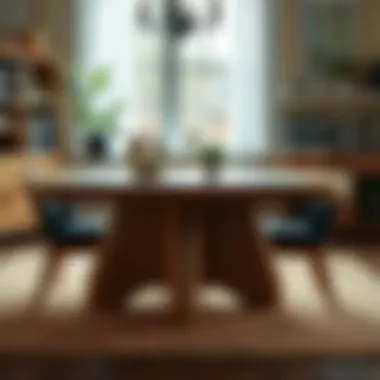Enhancing Your Puzzle-Making Table for Comfort and Fun


Intro
Creating the perfect environment for puzzle making can significantly enhance your experience and outcome. Imagine dedicating a corner of your home where creativity meets comfort, tailored to your puzzling needs. From the moment you pick up that first piece to the satisfying click of the last one fitting into place, the right setup can mean the difference between a joyful pastime and a frustrating chore.
In this exploration, we will unpack the essential details that go into designing a puzzle-making table. Everything from the dimensions and surface materials to ergonomic considerations and useful accessories will be dissected. Understanding these factors not only helps in selecting the right furniture but also ensures that your puzzling session is as leisurely as you want it to be.
Let’s dive deeper into some trends in furniture design that can help you create that ideal space—one that is both functional and visually appealing.
Understanding the Puzzle-Making Environment
Creating a dedicated space for puzzle making goes beyond just a table and some pieces. It embodies an entire environment that significantly influences your puzzle-solving experience. When considering the understanding of the puzzle-making environment, several factors come into play that enhance the overall process and outcome of assembling those intricate jigsaw pieces. This section seeks to elucidate these components, taking a closer look at historical nuances and modern trends that shape puzzle-making spaces today.
Historical Context of Puzzle Tables
Over the years, puzzle tables have transformed remarkably. In the early 20th century, before the advent of high-tech distractions, families often gathered around a central table to socialize and problem-solve together. Craftsmanship was prominent, and these tables were often made of solid oak or mahogany, designed for durability and aesthetics. They featured unique craftsmanship that reflected the maker's artistry.
Historically, these tables served dual purposes: not only were they functional for puzzles, but they also acted as gathering spots where families could connect over shared interests. The importance of these communal spaces cannot be understated—much like a modern-day coffee shop where ideas are exchanged, puzzle tables fostered engagement and collaboration. This historical significance is crucial for today’s puzzle enthusiasts, as it underlines the communal aspect of puzzling and how it was often perceived as an intellectual pastime.
Modern Trends in Puzzle-Making Spaces
Fast forward to today, and the landscape of puzzle-making has seen some interesting developments. People are often turning unassuming corners of their homes into vibrant puzzle oases. It’s not just about the table anymore; it’s about curating a space that inspires creativity and comfort.
- Niche Designs: Many recent designs feature multi-functional tables, which allow for seamless transitions between puzzle solving and other activities, fostering versatility in space use.
- Minimalism and Organization: The minimalist trend prevails, with individuals opting for sleek, tidy environments where everything has its place—this not only enhances aesthetics but also helps in maintaining focus on the task at hand.
- Sustainable Choices: There's a growing preference for eco-friendly materials, reflecting a greater consciousness about sustainability in home decor. Selecting wood from responsibly managed forests or recycled materials for your puzzle table can resonate well with environmentally-minded creators.
These modern elements show how a simple table has grown into a focal point of home decor that encompasses the essence of both leisure and functionality. Along with aesthetics, the arrangement and design of your puzzle-making space are evolving to be more user-centric, accommodating the needs of today’s puzzlers who value both comfort and practicality.
"A well-thought-out puzzle-making environment can elevate not only your game but also your mood."
In summary, understanding the historical backdrop and the trends that dictate today’s puzzle-making environments is vital. These elements play a significant role in optimizing the experience, making it enriching and enjoyable, while ensuring that the puzzle space feels tailored to your individual needs. Everyone from casual hobbyists to serious enthusiasts can draw inspiration from this exploration, realizing that the environment plays a crucial role in the enjoyment and satisfaction of their puzzling endeavors.
Essential Features of a Puzzle-Making Table
Creating a space dedicated to puzzle-making is not just about having a flat surface; it's about cultivating an environment that enhances the experience of piecing together those captivating images. One could argue that the features we incorporate into our puzzle tables can significantly affect both comfort and efficiency. The ideal setup marries functionality with aesthetics, allowing puzzle enthusiasts to lose themselves in their craft for hours without discomfort.
Optimal Dimensions for Comfort
Choosing the right dimensions for your puzzle-making table is as crucial as selecting the puzzle itself. It’s like getting the perfect pair of shoes – if they don’t fit well, you won’t be able to enjoy the journey. A table should generally allow enough space for the full puzzle and some extra room for sorting pieces without crowding.
Most enthusiasts find that standard tables with a height of about 28 to 30 inches and a width of 60 to 72 inches provide a comfortable working area. This height accommodates most chairs comfortably, ensuring that anyone engaged in puzzling does not strain their back or neck over time. For those who prefer to work while standing, adjustable table features can be a game-changer.
Additionally, consider depth. A table that is too narrow may cause pieces to fall off easily, while a depth of at least 30 to 36 inches allows ample room for lamps and other accessories. Ultimately, designing a space that caters to various needs enhances usability across different types of puzzles. A well-sized table invites creativity and engagement – that’s the crux of it.
Selecting Appropriate Materials
The materials that make up your puzzle table can significantly influence the table's durability and your overall experience. Solid wood options, like oak or maple, offer a timeless quality and stability, but they can come with a hefty price tag. Alternatively, engineered woods such as plywood provide a balance between cost and durability, especially when laminated.
If you’re the type who often spills coffee or needs a surface that can handle markers or notes, then considering materials that have a protective finish can save a lot of headache in the maintenance department. A tabletop with a scratch-resistant laminate will go a long way in preserving the table’s appearance over years of puzzling.


Moreover, consider how the materials resonate with your home décor. A sleek glass top might look stunning, but it might not be suitable for those who tend to perform a lot of precision piece manipulation, since pieces may easily slide around. The aim is to align both function and beauty.
Surface Texture Considerations
Now, let’s talk about textures. A smooth surface seems ideal at first glance, especially for sliding pieces into place. However, if it’s too slick, you may find that pieces tend to slide off or jostle around when you don’t want them to. A lightly textured finish could provide just enough grip to keep your pieces organized while still allowing for ease of movement.
Furthermore, think about how the texture interacts with other accessories. For example, if you primarily use organizers or trays, a textured surface may keep these items in place while you work. Also, textures can be visually pleasing; for instance, a table with a rustic finish not only looks charming but adds character to the whole room.
It's essential to strike a balance between aesthetics and functionality. The right surface texture can directly affect how much you enjoy assembling your puzzling masterpiece.
Overall, by emphasizing these features, anyone can create a puzzle-making table that's really a joy to use. Whether it’s a cozy nook in a family room or a grand station in a dedicated puzzle room, the right components matter more than one might think.
Ergonomics in Puzzle-Making
Creating an optimal puzzle-making environment goes beyond the mere selection of tables and chairs. Ergonomics, the science of enhancing comfort and efficiency in our surroundings, plays a critical role in how we engage with puzzles. One might think of ergonomics as a luxury feature, but it serves as the backbone to a productive and enjoyable puzzle experience. If you’re spending hours fitting tiny pieces together, comfort becomes paramount, influencing both enjoyment and physical well-being.
Proper ergonomics not only enhances your enjoyment but also minimizes fatigue and discomfort over long periods of puzzle-making. This section delves into three pivotal aspects:
Chair Selection and Comfort
When it comes to solving puzzles, the chair you settle into is just as significant as the table you use. A comfortable, supportive chair can transform a puzzling session from an experience of discomfort to one of pure bliss. Look for chairs that provide adequate lumbar support; after all, even the best puzzles can turn sour if you feel like you're wedged in a vice.
A few features to consider when selecting your chair include:
- Adjustability: Can the height be modified to suit your table?
- Cushioning: Is there enough padding to support prolonged sitting?
- Mobility: Consider a chair that can slide easily across the floor to reach different parts of your table without straining.
Ultimately, the right chair can elevate the entire puzzle-making experience, allowing puzzlers to lose themselves in their craft without the nagging ache that comes from poor posture.
Table Height Recommendations
Finding the appropriate height for your puzzle-making table is crucial. An improper table height can lead to unnecessary strain on your back, neck, and wrists. Ideally, when seated, your elbows should rest comfortably on the table, keeping your forearms parallel to the surface. This position alleviates pressure on the shoulders and prevents undue fatigue.
Here are some height guidelines to optimize your table setup:
- Standard Height: For most people, a height of 28-30 inches works well.
- Adjustable Tables: Consider a height-adjustable table that lets you switch between seated and standing positions, adding versatility to your puzzle sessions.
- Testing: Before making a final decision, try the table out for a while. Lean into your puzzle and see if you need to make any adjustments.
Not only does height matter, but having the right positioning can mean the difference between a delightful puzzle evening and ending up with discomfort.
Lighting Considerations
Good lighting is often overlooked when crafting a comfortable puzzle-making space. Insufficient lighting can lead to eye strain, headaches, and even frustration at not being able to see the pieces clearly. You want a setup that bathes your table in warm, even light without harsh shadows or glare.
Consider these lighting options:
- Natural Light: Position your table near a window for ideal daytime lighting. However, beware of direct sunlight that may cause fading over time.
- Task Lighting: A focused light source, such as a desk lamp with adjustable arms, ensures that light is directed precisely where you need it, illuminating the puzzle without distraction.
- LED Options: Energy-efficient LED lights provide bright, consistent illumination. Many options are available that allow customization in brightness and warmth, which can reduce eye fatigue.
"Proper lighting not only enhances visibility but makes the puzzle experience enjoyable, allowing you to immerse yourself in the work ahead."
Creating the ideal ergonomic environment for your puzzle-making activities is essential for both enjoyment and comfort. Investing time into selecting the right chair, table height, and lighting can drastically improve your experiences, allowing you to stay focused and engaged in the intricate world of puzzles.


Accessorizing Your Puzzle-Making Table
Accessorizing your puzzle-making table is not just about whimsy and flair; it's about creating an environment tailored to your puzzling needs. The right accessories can streamline the experience, keeping you organized, focused, and comfortable during those long hours of piecing together that challenging 1,000-piece image of a snowy forest. Accessories enhance functionality and also serve as an expression of personal style, making your puzzle space uniquely yours.
Puzzle Organizers and Trays
Having a range of puzzle organizers and trays is akin to using the right tools for cooking—imagine trying to bake without measuring cups. Organizers allow for effective sorting and grouping of pieces. Think about investing in tiered storage trays that can easily slide beneath your table or compact sorting bins with dividers. While sorting may seem tedious at the onset, it substantially speeds up assembly later.
- Benefits of Organization:
- Accelerated puzzle completion by reducing time spent finding pieces.
- Better focus on the task at hand; fewer distractions from searching.
- Maintaining a tidy workspace can reduce mental clutter, enhancing creativity and problem-solving.
Consider utilizing clear containers for visibility, as it avoids the game of hide and seek with your jigsaw pieces. You might also prefer an organizing mat where you can lay out the pieces, keeping them secure from spills or disturbances. A good design to look for could be inspired by the clever layouts found in commercial jigsaw puzzling kits.
Magnifiers and Tools
The beauty of puzzles often lies in the intricate details, which can sometimes be challenging to see clearly, especially as the hours tick by. Here, magnifiers become your best allies. A portable magnifying glass, or even a lamp with built-in magnification, can help you inspect those tiny printed images, allowing you to immerse fully into the puzzle's nuances.
In addition to magnifiers, consider adding specialized puzzle tools:
- Separation tools that help reposition pieces without bumpy fingers
- Tweezers for intricate placement, especially useful in smaller puzzles, where control is vital.
- Lightweight, easy-grip scissors for trimming edges if the puzzle is a custom-made piece.
Creating a Display Area
Once you've completed a puzzle, showcasing your hard work is natural. Making a display area not only celebrates your finished pieces but also adds aesthetic value to your room. Think about where your completed puzzles will go—do you want them framed, or maybe displayed on a floating shelf?
Some ideas for a display area:
- Utilize deep picture frames with a glass front to preserve and showcase your work.
- Create themed shelves that reflect your personality; for instance, a corner devoted entirely to landscapes, or abstract art based on your tastes.
- Use pins and boards to change out pieces frequently, allowing for an evolving art show.
Having that display area can make your puzzling space feel complete, merging function with style. It not only delights the viewer but also adds a sense of accomplishment as you step back and relish in your artistic endeavor.
A well-accessorized puzzle-making table acts as both a workspace and a canvas, reflecting your journey through the intricate art of puzzling.
By meticulously selecting and arranging your accessories, you can create an encouraging and inspiring environment that makes every puzzle session an enjoyable endeavor. For related guidelines and inspiration, you can explore additional resources such as Britannica and community insights on platforms like Reddit.
Maintaining Your Puzzle Space
Maintaining your puzzle space is more than just routine cleaning; it’s about preserving the integrity of your materials while ensuring a pleasant working environment. A well-kept space not only enhances the aesthetic but also promotes an efficient puzzle-making experience. Let’s delve into the pivotal elements that contribute to a tidy and optimized puzzle zone.
Cleaning and Care for Materials
Cleaning your puzzle-making materials regularly plays a crucial role in ensuring their longevity. Dust, crumbs, and accidental spills can compromise both wooden boards and the quality of the puzzles themselves. Here are some practical tips:
- Dust Regularly: Use a soft microfiber cloth to gently wipe surfaces. Accumulated dust can scratch surfaces over time, especially on wooden tables.
- Handle Puzzles with Care: When organizing or placing pieces, avoid applying too much pressure which can lead to wear. Storing puzzles in dedicated containers can also minimize exposure to dust and moisture.
- Work with Natural Products: For cleaning wooden tables or accessories, opt for natural oils or waxes once in a while to preserve the finish. This keeps the wood looking fresh and prevents it from drying out.
- Assure Good Airflow: A clean, breathable workspace helps in preventing moisture build-up which affects both your workspace and puzzles. If you live in a humid area, consider using a dehumidifier.
Keeping these materials in pristine condition will enhance your experience when piecing together your favorite puzzles and maintain the overall quality of your workspace.


Reorganizing for Efficiency
A cluttered workspace can stifle creativity and focus. Thus, reorganizing your puzzle-making space is essential to streamline the entire puzzle process. Here are a few strategies:
- Create Designated Zones: Separate areas for sorting pieces, assembling puzzles, and storing materials help in maintaining a flow. It minimizes chaos and makes transitioning between steps smooth.
- Utilize Clear Containers: For sorting, clear containers allow you to see what’s inside at a glance. This saves time when looking for specific pieces, negating the need to rummage through piles.
- Implement a Rolling Cart: If space is tight, using a rolling cart can be a game-changer. It offers flexibility to move your materials closer or further as needed and can be easily tucked away when not in use.
- Take Inventory Regularly: Go through your materials every few months to discard unused or broken pieces. This not only declutters your space but helps you stay organized and efficient.
By fostering an efficient workspace, you not only heighten your productivity but also make the activity more enjoyable.
Remember: A well-maintained puzzle space not only boosts the enjoyment of the activity but can also significantly enhance focus and efficiency.
Customizing Your Puzzle-Making Experience
Customizing your puzzle-making experience is more than just a personal flair; it’s about creating a space that nurtures your passion and enhances the joy of solving puzzles. Everyone has a different style, and making your puzzle area reflect this individuality can significantly influence not only your comfort but also how you engage with your puzzles. A tailored environment helps you feel more connected to the craft, possibly leading to longer, more enjoyable sessions. But how does one go about this? Let’s break down the specifics.
Incorporating Personal Touches
Infusing personal touches into your puzzle table not only makes it unique but also resonates with your character and preferences. Consider these aspects when customizing:
- Artwork and Decorations: Hang up some artwork or maybe a framed photo that inspires you. This can help invigorate the atmosphere and make it feel less sterile. You could feature puzzles you've completed or a motivational quote that fuels your dedication.
- Color Schemes: Choose colors for your table or surrounding area that soothe or excite you. Soft pastels may promote calmness, while vibrant hues could elevate energy levels.
- Custom Accessories: Sewing or buying a customized tablecloth can set the tone for your puzzle area. Similarly, you can create or purchase personalized trays that organize pieces in a way that feels right for your style.
Even simple touches like a favorite mug for your beverages or comfortable cushions can elevate the experience. Remember, it’s the little things that can pull everything together.
Adjusting for Different Puzzle Types
Every puzzle comes with its own set of challenges and thus may need some tweaking in your setup. Here are a few points to consider:
- Size and Complexity: Bigger puzzles require more space. Think about adjustable tables that can expand based on your project. If you’re tackling a 1000-piece puzzle, ensure you have enough surface area not just for the puzzle itself, but for sorting pieces and accessing reference images.
- Type of Puzzles: Different puzzles—like jigsaw puzzles versus 3D puzzles—necessitate different approaches. For 3D puzzles, you might want specialized stands or supports that can elevate the piece and make it easier to work on.
- Group Activities: If you enjoy puzzling with family or friends, ensure the table can accommodate multiple participants. A round or wide table might encourage collaboration and help everyone access pieces easily.
Ultimately, it’s vital to understand that while the charm of puzzling often lies in its simplicity, the setup can very much dictate your experience. Customization improves not just efficiency but creates a space that feels cozy and inviting.
"Creating an engaging puzzle zone can turn an ordinary activity into an extraordinary experience. Let your creativity shine through your setup."
For more personalized tips and shared experiences, consider visiting forums like Reddit where fellow enthusiasts exchange ideas or checking out Pinterest for visual inspiration.
Crafting a table that not only serves its primary purpose but also mirrors your personality can make all the difference in your puzzle journey.
Culmination: The Ideal Puzzle-Making Table
Crafting the perfect puzzle-making table is no small feat, but the rewards are well worth the effort. A well-optimized table enhances not just the experience of assembling puzzles but also fosters creativity and relaxation. The relationship between your space and the puzzles you tackle can literally affect the enjoyment and engagement you derive from your hobby.
In this article, we’ve unraveled the layers behind what makes a puzzle table ideal. From understanding your ideal dimensions to the right materials, the considerations are many and nuanced. Ergonomics plays a massive role here as you want to embrace comfort while diving into your puzzling endeavor. An ideal chair coupled with a perfectly proportioned table height can reduce fatigue.
This section not only discusses the foundational elements that contribute to an excellent table but also emphasizes personalization. When one tailors their setup to cater to personal styles or specific puzzle types, they're more likely to find joy and satisfaction in the process.
The Importance of Customization
Customizing your zone allows for optimizing your efficiency. Puzzle trays, organizers, or even display areas can significantly elevate your overall experience. Such modifications open gateways to deeper engagement, making puzzle-solving feel more like a personal escape than just a task.
This leads to our concluding thoughts. Achieving an ideal puzzle-making table is not just about having the right setup; it’s about crafting an environment that resonates with you. Puzzles are not just simple tasks, but rather portals to creativity, problem-solving, and relaxation. Therefore, invest time in optimizing your space. This not only enhances your immediate experience but can also affect your long-term relationship with puzzles.
Summarizing Key Takeaways
- Suitability Matters: Choose dimensions and materials that maximize comfort and functionality.
- Ergonomic considerations: Opt for the right height and a good chair to ward off discomfort.
- Accessory Integration: Select items that allow for better organization and display to heighten the joy of puzzle-solving.
- Personalization: Infusing your unique touch into the table can turn an ordinary task into an extraordinary ritual.
Ultimately, your puzzle-making table can be a sanctuary of sorts—a place where you find both leisure and creativity combined. In the end, it’s this harmony that will either enrich your experience or leave you frustrated.



